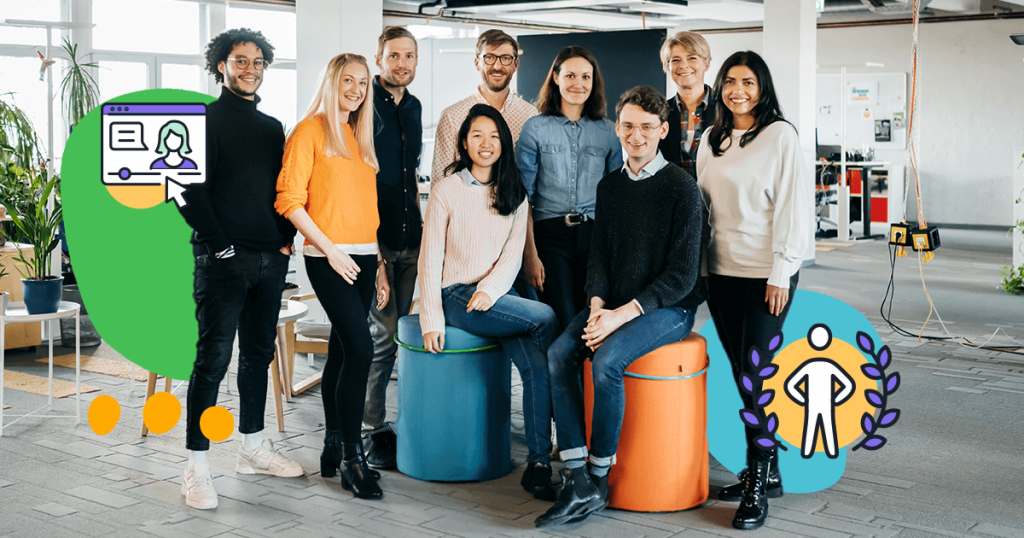Discussions around the topic of Diversity, Equity and Inclusion (DEI) have never been so firmly placed on companies’ agendas. This could be for all kinds of reasons: demands from employees, pressure from investors, Marketing strategies, or even the simple fact that companies agree that it’s the right thing to do — as we believe at Rock Content.
Regardless of the reasons that move the actions, soon, we’ll see with more and more research that this is not a passing wave. People are more concerned about Diversity, Equity and Inclusion (DEI), and when we talk about people, we’re talking about consumers, of course, but also about employees.
It’s no longer an option for companies to start working on issues of diversity and inclusion, just as it’s not an option for companies to have ethical behavior and follow compliance standards.
On the other hand, it’s not uncommon to see managers at all levels often lost, questioning which actions to prioritize: “How can I become an inclusive leader? How do I manage a diverse team?”
Some may even (still) wonder if caring about it will actually have a significant, positive effect on the team.
Well, the answer is: yes. We’ll go deeper into numbers, stories and data that show that having more diversity in companies is not only beneficial to the results, but dare I say crucial. I’ll share what I’ve learned as the leader of DEI at Rock Content with our efforts to build a more diverse and inclusive environment for our employees, the 400 Rockers distributed across 20 countries globally.
Inside the companies
Concepts of Diversity, Equity and Inclusion have been built in the corporate environment and in universities over the last 30 years.
The intensification of globalization processes meant that multinationals had to interact with the diversity not only of consumers, but also with the diversity of their workforce in other countries. Then the first challenge arises: How can I produce products and offer services to people so different from me?
Managers started looking at their employees and realized that people looked too much like each other, and something needed to be done. Allied to this, there is no way to detach from the struggle of social movements around the world. Society has begun to have a better understanding of the effects of discrimination in the corporate environment as well.
The achievements of rights of groups in historically underrepresented places of power, and the understanding that without affirmative action only a few changes would be possible, turns a key in the business models and management of companies.
The real value of Diversity
In case you are still not convinced that companies are directly affected by social issues and that, in turn, need to be allies in the fight against inequalities, I bring other data that people who work with diversity already noticed, but which is now proven in numbers:
- 83% of millennials are more engaged when they think their company fosters an inclusive culture. (Deloitte)
- Companies in the top quartile of gender diversity are 15% more likely to have financial returns above their national industry median. Companies in the top quartile of racial/ethnic diversity are 35% more likely to have financial returns above their national industry median. (McKinsey)
- Companies reporting the highest levels of racial diversity brought in nearly 15 times more sales revenue on average than those with the lowest levels of racial diversity. (Science Daily).
- More diverse companies are 70% more likely to capture a new market. They’re also 45% more likely to report increased market share year-over-year. (Harvard Business Review).
As you just saw above, working on the topic of diversity and inclusion is not only the right thing to do (social responsibility), but also the smartest thing to do (everyone wins).
It’s not one thing or another, one campaign or support. Your brand needs to have a general genuine concern about diversity, equity and inclusion. It has to come from the inside out. It has to be felt from your newest intern to your most important customer.
How Rock Content has converted discourse into practical actions
It’s true that these concepts have always been part of Rock Content’s values since 2013, when we were founded. However, it was only in 2019 that we officially structured our Social Impact and Diversity, Equity and Inclusion areas. As you can see, it’s also relatively new to us.
But we’ve come a long way since then, so we can share some victories, actions, and lessons learned.
In the past three years, we have been promoting events, lectures and workshops on these topics. We’ve carried out volunteer activities on education and employability, connecting Rockers with their purpose of positively impacting the world.
And how do we manage these actions? In addition to the Social Impact and DEI team, we have the support of the Rocker Network Groups. They are groups focused on five pillars: gender equity (Women Rock and Parents at Rock); racial equity (AfroRock); accessibility (Inclusion Rock), focused on people with disabilities; identity (Roqueer), with a focus on the LGBTQIAP+ community; and giveback (Rock.org), working on volunteer issues.
Through these groups created organically by employees, we were able to bring management, representation and more people to inclusion practices. In a decentralized way, but connected to the whole, we propose that the teams themselves review their processes.
Another example of this is what the Talent Acquisition (TA) team has been doing. The team has reviewed all of its attraction and recruitment processes to bring diverse talent to the company.
The first step was training the team to recruit and have a diverse pipeline. Along with that, we recently held training with the TA team on people with disabilities, with best practices in terms of hiring and attraction.
We also did a methodological review on the accessibility of our technical tests and whether they are flexible and accessible to neurodiverse people, for example.
Last but not least, we structured affirmative job positions. Today we have a process for opening job positions, which starts with creating a job posting (using inclusive communication), goes through the sensitization of leaders, and then to the complete experience of the candidates.
It is important to remember that this benefits all people, not just those we perceive as underrepresented groups. We are talking about a more humanized hiring process.
Another concern that Rock Content has is moving the structures. We can mention the recent update of our parental leave policy, considering all family formats, allowing anyone, regardless of their affective-sexual orientation or gender identity, to request the longest period of leave (120 days), regardless of location/country in which this person is located.
We are getting to the end of the article, but not to close this topic just yet. I feel there is a need to share some final words with you: I know that the challenge can be scary. But the fear of failure (or not getting the results you might expect) has to be less than the fear of not offering a healthy and welcoming environment to all people involved in your brand — employees, customers, stakeholders, and partners.
As Larry Hirst said in the book Inclusive Leadership: “We have come a long way, but we haven’t come far enough and the pace of change should be faster. We need to continually learn and assess what works and what doesn’t work, we need to engage and collaborate with our colleagues at all levels of our organization, and we need to convert our fine words into demonstrable and impactful actions.”
Let’s be the change.
This article is also in the new issue of Rock Content Magazine, released this August. In this issue we bring incredible content about diversity, inclusion and accessibility, an extremely important topic for brands and society today. You can download the magazine here, it’s completely free! Good reading!

![[EN] RCM#6](https://rockcontent.com/wp-content/uploads/2022/08/08_03-E-mail-Banner-03-1-1.png)






